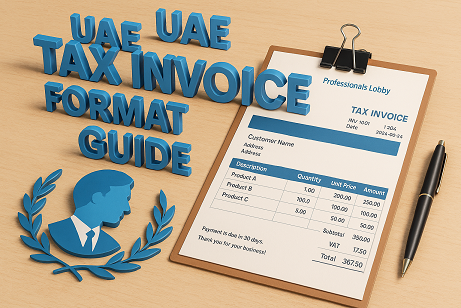Proper tax invoice formatting is critical for UAE businesses to maintain VAT compliance and prepare for upcoming e-invoicing mandates. This comprehensive guide covers all mandatory elements of UAE tax invoices, explains FTA requirements, provides sample templates, and addresses complex scenarios like multiple branches, van sales, discounts, and advance payments. Updated for 2024 regulations and e-invoicing implementation phases.
Quick Navigation
Two Invoice Types: Standard vs Simplified
UAE VAT law requires different invoice formats based on transaction value and customer type:
Standard Tax Invoice
Required for:
- All B2B transactions
- Transactions ≥ AED 10,000
- When recipient requests full invoice
Features: Contains all 14 mandatory elements specified by FTA
Simplified Invoice
Allowed for:
- B2C retail sales under AED 10,000
- Transactions where full details aren't required
Minimum requirements:
- Supplier name and TRN
- Invoice number and date
- Total amount payable
- VAT amount charged
Mandatory Elements of a Standard Tax Invoice
FTA requires these 14 elements on all standard tax invoices:
1. "Tax Invoice" Title
Must be clearly visible at the top to identify the document as a VAT invoice.
2. Supplier Details
Legal/trading name, full UAE address, and Tax Registration Number (TRN).
3. Recipient Details
Customer name and address. Include TRN for VAT-registered businesses.
4. Unique Invoice Number
Sequential number that's never reused. Must be unique per supplier.
5. Issue Date
Date when the invoice was issued to the customer.
6. Supply Date
Date when goods/services were provided (if different from issue date).
7. Goods/Services Description
Clear line-item description of each supplied item or service.
8. Quantity & Unit Price
For each line item: quantity supplied and price per unit.
9. Taxable Amount
Net amount for each line before VAT application.
10. VAT Rate
VAT percentage applied to each line (5%, 0%, or exempt).
11. VAT Amount
Monetary VAT amount for each line item.
12. Total Amount Payable
Final amount due including VAT, in AED.
13. Total VAT Payable
Sum of all VAT amounts on the invoice.
14. Special Mechanism References
If applicable, reverse charge notation or other special cases.
Tax Invoice Sample with Annotations
Below is a compliant UAE tax invoice with key elements annotated:
TAX INVOICE
Supplier
Professionals Lobby LLC
Business Bay, Dubai, UAE
TRN: 123456789000000
Customer
ABC Trading FZE
Jebel Ali Free Zone, Dubai, UAE
TRN: 987654321000000
| Description | Qty | Unit Price (AED) | Net Amount (AED) | VAT Rate | VAT Amount (AED) |
|---|---|---|---|---|---|
| ERP Implementation Services | 10 | 1,200.00 | 12,000.00 | 5% | 600.00 |
| Annual Support Package | 1 | 5,000.00 | 5,000.00 | 5% | 250.00 |
| Discount - Early Payment | -500.00 | ||||
| Subtotal | 16,500.00 | ||||
| VAT Total | 850.00 | ||||
1 "Tax Invoice" Title
Must be prominently displayed at the top to identify the document as a VAT invoice.
2 Supplier Details
Legal name, UAE address, and TRN are mandatory for all tax invoices.
3 Invoice Numbering
Unique sequential number with branch/device identifier (PL-DXB).
4 Customer Details
Customer name, address, and TRN (required for B2B transactions).
5 Line Item Details
Clear description, quantity, unit price, and net amount for each item.
6 VAT Application
VAT rate and amount shown per line item as required by FTA.
7 Discounts
Shown as separate line items that reduce the taxable base.
8 Totals
Clear display of net amount, VAT total, and final amount due.
9 Payment Details
Bank information and payment terms for customer reference.
10 Special Mechanisms
Reverse charge notification when applicable.
Invoice Numbering Rules & Patterns
FTA requires unique sequential invoice numbering with strict controls:
Key Requirements
- Each invoice must have a unique identifier
- Numbers must be sequential (no gaps)
- Numbers must never be reused
- Maintain audit trails for all invoices
Recommended Numbering Patterns
Single Location:
INV-2024-00127
Sequential numbering with year identifier
Multiple Branches:
DXB-INV-2024-00542
Branch prefix + sequential number
Van/Mobile Sales:
VAN03-2024-00089
Device ID + sequential number
E-Invoicing:
EINV-123456789
Electronic invoice reference ID
Implementation Best Practices
- Centralize numbering control where possible
- Implement daily reconciliation for branch/van sales
- Use accounting software with built-in controls
- Document correction procedures for gaps/duplicates
- Maintain master list of all numbering series
E-Invoicing Requirements & Implementation
UAE is implementing phased e-invoicing with new technical requirements:
Phase 1: Preparation (2024)
Businesses should assess current systems, select accredited service providers, and plan integration.
Action Required Audit current invoicing processes and document gaps
Phase 2: Integration (2025)
Implement system changes, integrate with accredited providers, and test e-invoice generation.
Action Required Update ERP/POS systems and train staff
Phase 3: Compliance (2026)
Full implementation with mandatory electronic reporting and validation.
Action Required Implement continuous monitoring and validation
QR Code Requirements
QR codes are not universally required but recommended for certain scenarios:
- Tourist VAT refunds: Mandatory QR codes for eligible purchases
- Retail transactions: Recommended for consumer verification
- E-invoice validation: May contain essential validation data
Businesses should monitor FTA updates as requirements may evolve with e-invoicing phases.
Special Invoice Treatments
FOC (Free of Charge) & Promotional Offers
VAT Treatment:
Free items may be considered deemed supplies if input VAT was recovered. Document all promotional items with:
- Cost/value of items distributed
- Input VAT recovery status
- Business justification for distribution
Best Practice Issue internal documentation for all FOC items with above details
Discounts & Additions
Discounts:
Must reduce the taxable base before VAT calculation. Show as separate line items with clear description.
Example: "Early Payment Discount - 5%"
Additions:
Shipping, handling, or service fees are part of taxable value. Show as separate line items with VAT application.
Example: "Delivery Charge - AED 50"
Advance Payments & Deposits
VAT is due when advance is received. Implementation steps:
- Issue tax invoice/receipt for advance payment showing VAT charged
- Account for VAT in the period when advance was received
- At final supply, issue final tax invoice referencing advance
- Adjust VAT for any difference between advance and final amount
Critical Maintain clear references between advance and final invoices
VAT Invoice Do's and Don'ts
Do's
- Show your TRN on every invoice
- Use unique sequential numbering
- Show VAT rate and amount per line
- Issue invoices for advance payments
- Keep records for 5 years minimum
- Prepare systems for e-invoicing
- Document promotional item policies
Don'ts
- Reuse invoice numbers
- Hide discounts or additions
- Show TRN if not registered
- Assume free samples are non-taxable
- Issue "Tax Invoice" without TRN
- Delay e-invoicing preparation
- Forget foreign currency conversion
Zero-Rated & Exempt Supplies
Zero-Rated (0%)
- Exports outside GCC
- International transportation
- Certain healthcare services
- Qualifying educational services
- Investment precious metals
- New residential buildings (first 3 years)
Note Input VAT may be recoverable
Exempt Supplies
- Certain financial services
- Residential property leases
- Bare land sales
- Local passenger transport
- Some government charges
Note Input VAT not recoverable
Frequently Asked Questions
QR codes are not universally required for all printed invoices. The MoF/FTA e-invoicing regime focuses on electronic transmission and validations; printing a QR is not a blanket requirement, although some use cases (tourist refunds, retail tags) use QR codes. Always check the technical spec for the phase you are implementing.
Show VAT rate and VAT amount per line, and aggregate totals. The taxable base should be clear and discounts applied before VAT should be shown in the calculation. FTA guidance explicitly asks that unit price, quantity, VAT rate and VAT amount be derivable.
Use either a single central series or branch/device prefixes to keep uniqueness; record device IDs and sync daily. Have a documented reconciliation and correction policy. For van sales, use device-specific series (VAN01-2024-00089) and implement daily reconciliation to central system.
Free gifts/samples may be treated as deemed supplies (taxable) if input VAT was reclaimed on the item; trivial gifts may be excluded — document policies and consult FTA sector guidance. Always maintain records of cost/value and input VAT recovery status for all promotional items.
Discounts reduce the taxable value (Article 39 of the VAT law). Additional fees (delivery, packing) are part of taxable value unless specifically exempt. Show calculations explicitly as separate line items.
VAT is normally due when the advance is received; issue an invoice/receipt at receipt and reconcile with the final invoice at supply. Maintain clear references between advance and final invoices to avoid double taxation.
If you are VAT-registered you must include your TRN. If you are not registered, do not issue a tax invoice (you cannot lawfully charge VAT or show a TRN you don't have). Unregistered businesses should issue commercial invoices without VAT.
Some government services are taxable, some are exempt — check the specific fee/service and FTA guidance. Many government fees have special treatment, so consult the FTA's sector guides for details.
FTA imposes administrative penalties for missing or incorrect tax invoices, including AED 5,000 for first offense and AED 15,000 for repeated offenses within 24 months. Additional penalties apply for failure to keep proper records.
Resources & Downloads
Sample Tax Invoice Template
Compliant UAE tax invoice template in editable format
Download DOCXFree to use for your business
50+ VAT Q&A Document
Comprehensive answers to all UAE VAT questions
Download PDFUpdated for 2025 regulations
FTA Compliance Checklist
Step-by-step verification for tax invoices
Download ChecklistPrintable document format
Next Steps for Your Business
Implementing compliant tax invoices requires careful planning, especially with e-invoicing mandates approaching. Professionals Lobby offers specialized services to ensure your invoicing meets all FTA requirements:
Invoice Template Audit
We review your current templates against FTA requirements and e-invoicing standards.
Numbering System Design
We create robust numbering schemes for multi-branch and mobile sales operations.
ERP/POS Integration
We integrate your systems with accredited e-invoicing providers and implement validation.
Staff Training
Comprehensive training on invoice handling, discounts, advances, and record keeping.
Compliance Monitoring
Ongoing monitoring to ensure continuous compliance with evolving regulations.
Get Expert Help with UAE Tax Compliance
Our VAT specialists will ensure your invoicing meets all FTA requirements and prepare you for e-invoicing.
Schedule Consultation


